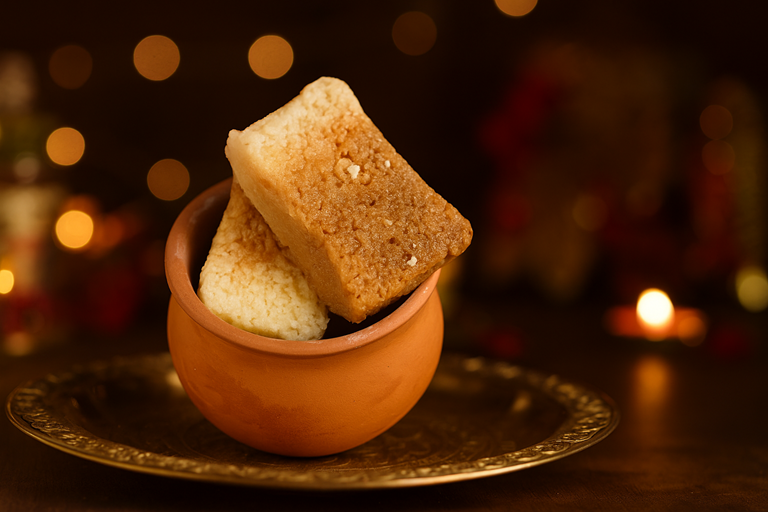Every sweet has a story, but few are as intriguing as that of Alwar Kalakand. This iconic milk cake, with its unique grainy texture and rich, caramelized flavor, is more than just a dessert; it’s a piece of India’s culinary heritage and a symbol of artisan perfection. While you may have savored its delicious taste, do you know the fascinating history behind how this legendary sweet came to be?
At Mishticue.com, we are the custodians of this sweet legacy. We believe that to truly appreciate an authentic sweet, you must understand its journey. Our Alwar Kalakand is not just a product; it’s a living tribute to the masterful halwai who created it and the tradition that has kept it pure.
The Birth of a Legend: The Halwai Who Made History
The story of Alwar Kalakand begins in the princely state of Alwar, in the heart of Rajasthan. The year was 1947, a time of great change. A renowned sweet maker, Baba Thakur Das, had recently migrated to Alwar and set up a sweet shop. He was determined to create a unique sweet that would be remembered for its texture and taste.

One day, while preparing a batch of kalakand, he noticed that the milk had been cooked for much longer than usual. Instead of discarding the batch, he decided to continue the process, pushing the boundaries of the traditional recipe. The result was a revelation: the milk had transformed into a delectable, crumbly, and caramelized sweet that was unlike any other mithai. This happy accident, born out of experimentation and a dedication to his craft, gave birth to the Alwar Kalakand we know and love today.
The Secret to Its Soul: Why Alwar Kalakand is Unique
What sets Alwar Kalakand apart from other milk cake varieties is its distinctive two-stage cooking process.
- Stage 1: The
KhoaFoundation: The process begins with fresh, full-fat milk, which is slow-cooked over low heat for hours until it reduces into a soft, creamykhoa. This step requires immense patience and constant stirring to prevent the milk from sticking to the bottom. - Stage 2: The Caramelized Heart: The crucial final step involves cooking the
khoafor a second time, this time with a precise amount of sugar, until the mixture starts to caramelize and turn a light brown. This is where the magic happens, giving the sweet its signature rich flavor and grainy, melt-in-the-mouth texture. The use of pure ghee throughout the process enhances this flavor, making it truly unforgettable.
A Sweet Journey: From Local Treat to Pan-India Favorite
The fame of Baba Thakur Das’s creation quickly spread throughout Alwar and beyond. The Rajasthan sweets became a must-have for every traveler and a cherished gift for every occasion. Its ability to last longer than other traditional sweets made it a perfect gift to carry across long distances. This is a testament to its quality and a reason it remains popular even today.
Mishticue: Preserving a Legacy, One Bite at a Time
At Mishticue.com, we are deeply inspired by the story of Alwar Kalakand. We have adopted the very same traditional method of slow-cooking and a commitment to using only the finest, purest ingredients to craft our mithai. Every bite of our Alwar Kalakand is a taste of this history—a tribute to the artisan who dared to be different and the legacy of his creation.
We are proud to continue this journey by making this legendary sweet accessible to everyone. With our trusted Pan India delivery, you don’t need to travel to Rajasthan to experience its authentic taste. We bring history, purity, and a slice of this traditional mithai directly to your doorstep.
Conclusion: Experience History, Delivered to You
The story of Alwar Kalakand is a beautiful reminder that tradition, when met with innovation and integrity, can create something truly timeless. It is a sweet that carries the heart of Rajasthan and a history as rich as its flavor. By choosing Mishticue.com, you’re not just buying a sweet; you’re celebrating a legend.
Alwar Kalakand, Alwar sweet history, authentic sweets, culinary heritage, milk cake, Mishticue.com, Pan India delivery, pure ghee, Rajasthan sweets, traditional mithai

